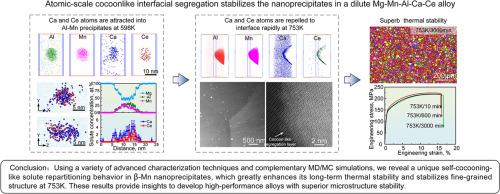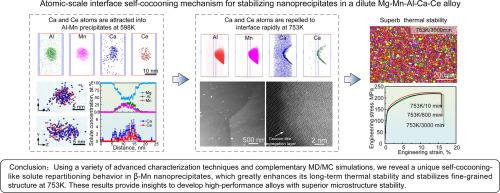Atomic-scale cocoonlike interfacial segregation stabilizes the nanoprecipitates in a dilute Mg-Mn-Al-Ca-Ce alloy
IF 9.3
1区 材料科学
Q1 MATERIALS SCIENCE, MULTIDISCIPLINARY
引用次数: 0
Abstract
Achieving densely distributed and thermally stable nanoprecipitates is critical in the development of Mg alloys suitable for long-time thermal exposure at elevated temperatures. Herein, highly stable β-Mn nanoprecipitates with a high volumetric number density (∼1.1 × 1020 m-3) are created in a dilute Mg-0.6Mn-0.5Al-0.2Ca-0.3Ce (wt.%) alloy, which stem from the formation of a unique core-shell structure characterized by a Ca-Ce cocoonlike segregation layer. Through detailed multi-scale characterizations and Molecular Dynamics/Monte Carlo simulations, we reveal that the segregation layer forms through a complex dynamic solute repartitioning behavior, wherein Ca and Ce, attracted into the β-Mn nanoprecipitates during hot rolling at 598 K, are repelled toward precipitate interface upon subsequent thermal exposure at 753 K. This process is driven by the changes in the local strain fields that arise from the increased Mn/Al ratio in the β-Mn nanoprecipitates. These core-shell β-Mn nanoprecipitates effectively stabilize the fine-grained structure (∼13-16 μm), with negligible degradation of yield strength when extending exposure time from 10 min to 3000 min at 753 K, i.e., ∼82% of the melting point of pure Mg. Our work illustrates how solute atoms with large differences in diffusivities can work synergistically to form densely distributed and highly stable nanoprecipitates even in a dilute Mg alloy, and the results could provide new insights into the development of high-performance alloys with superior microstructure stability.


原子尺度的茧状界面偏析稳定了稀Mg-Mn-Al-Ca-Ce合金中的纳米沉淀物
实现密集分布和热稳定的纳米沉淀物是开发适合在高温下长时间热暴露的镁合金的关键。本文在Mg-0.6Mn-0.5Al-0.2Ca-0.3Ce (wt.%)的稀合金中制备了具有高体积数密度(~ 1.1 × 1020 m-3)的高稳定β-Mn纳米沉淀,这是由于形成了独特的核壳结构,其特征是Ca-Ce茧状偏析层。通过详细的多尺度表征和分子动力学/蒙特卡罗模拟,我们揭示了偏析层是通过复杂的动态溶质重分配行为形成的,其中Ca和Ce在598 K热轧时被吸引到β-Mn纳米沉淀中,在随后的753 K热暴露时被排斥到沉淀界面。这一过程是由β-Mn纳米沉淀物中Mn/Al比增加引起的局部应变场变化驱动的。这些核壳β-Mn纳米沉淀物有效地稳定了细晶结构(~ 13-16 μm),当在753 K(即纯Mg熔点的~ 82%)下暴露时间从10分钟延长到3000分钟时,屈服强度的下降可以忽略不计。我们的研究表明,即使在稀释的镁合金中,具有较大扩散系数差异的溶质原子也可以协同作用形成密集分布且高度稳定的纳米沉淀物,这一结果可以为开发具有优越微观结构稳定性的高性能合金提供新的见解。
本文章由计算机程序翻译,如有差异,请以英文原文为准。
求助全文
约1分钟内获得全文
求助全文
来源期刊

Acta Materialia
工程技术-材料科学:综合
CiteScore
16.10
自引率
8.50%
发文量
801
审稿时长
53 days
期刊介绍:
Acta Materialia serves as a platform for publishing full-length, original papers and commissioned overviews that contribute to a profound understanding of the correlation between the processing, structure, and properties of inorganic materials. The journal seeks papers with high impact potential or those that significantly propel the field forward. The scope includes the atomic and molecular arrangements, chemical and electronic structures, and microstructure of materials, focusing on their mechanical or functional behavior across all length scales, including nanostructures.
 求助内容:
求助内容: 应助结果提醒方式:
应助结果提醒方式:


